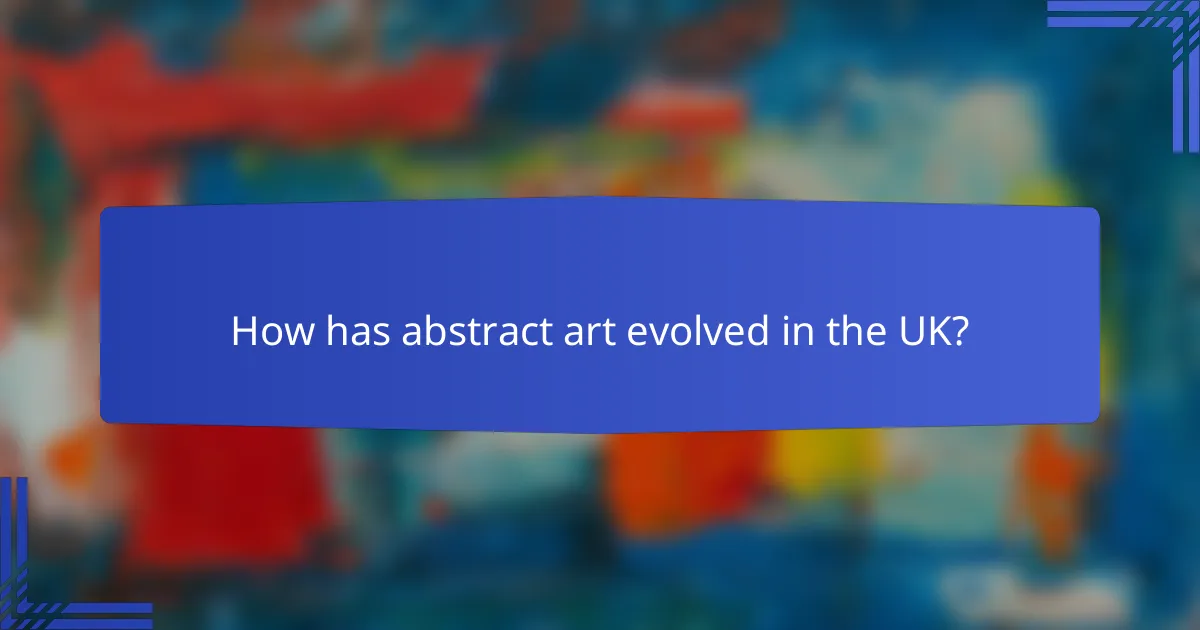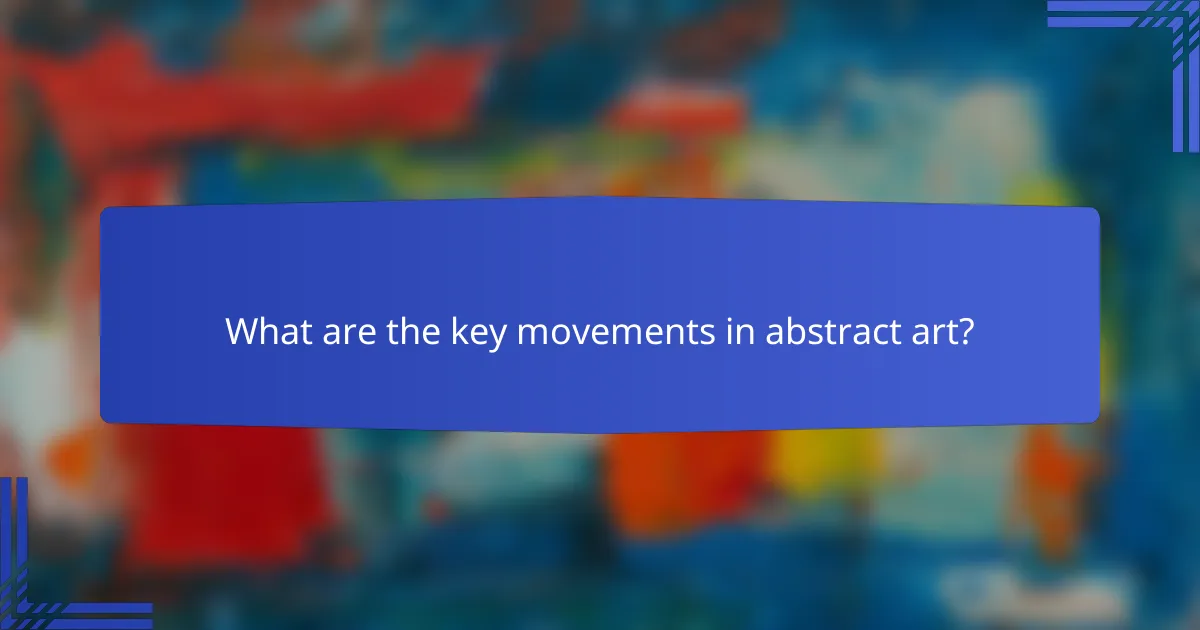Abstract art has undergone a remarkable evolution since the early 20th century, mirroring societal changes and the impact of technology on artistic expression. From its roots in movements like Cubism and Futurism, it has branched into diverse styles such as Abstract Expressionism and Geometric Abstraction, each offering unique perspectives and techniques. The advent of digital technology has further revolutionized the field, enabling artists to explore new creative avenues and reach wider audiences than ever before.

How has abstract art evolved in the UK?
Abstract art in the UK has evolved significantly from the early 20th century to the present, reflecting changes in society, technology, and artistic expression. Initially rooted in movements like Cubism and Futurism, it has since diversified into various styles and approaches, influenced by cultural shifts and technological advancements.
Key historical milestones
The evolution of abstract art in the UK can be traced through several key milestones. The early 1900s saw the emergence of artists like Wyndham Lewis and the Vorticist movement, which emphasized dynamic forms and bold colors. The post-World War II era introduced artists such as Barbara Hepworth and Ben Nicholson, who explored abstraction through sculpture and painting, leading to the St Ives School’s prominence.
In the 1960s, the rise of British Pop Art, with figures like Richard Hamilton, brought a new perspective to abstraction, merging popular culture with fine art. The late 20th century saw the emergence of artists like Damien Hirst and Tracey Emin, who challenged traditional notions of abstraction and incorporated conceptual elements into their work.
Influential artists in the UK
Several influential artists have shaped the landscape of abstract art in the UK. Barbara Hepworth is renowned for her organic sculptures that emphasize form and space, while Ben Nicholson’s paintings often feature a blend of abstraction and still life. Both artists played pivotal roles in defining the British abstract movement.
Another significant figure is Bridget Riley, known for her op-art works that create optical illusions through geometric patterns. Her contributions highlight the intersection of abstraction and perception, influencing a generation of artists. Contemporary artists like Anish Kapoor continue to push the boundaries of abstract art, exploring new materials and concepts.
Impact of cultural movements
Cultural movements have profoundly impacted the evolution of abstract art in the UK. The feminist movement of the 1970s, for example, encouraged female artists to explore abstract forms as a means of expressing identity and challenging societal norms. Artists like Rachel Whiteread and Sarah Lucas have incorporated these themes into their work, expanding the dialogue around abstraction.
The globalization of art in the late 20th and early 21st centuries has also influenced UK abstract artists, leading to a fusion of styles and ideas from around the world. This cross-pollination has resulted in a more diverse and inclusive approach to abstraction, reflecting a broader range of experiences and perspectives in contemporary art.

What are the key movements in abstract art?
The key movements in abstract art include Abstract Expressionism, Geometric Abstraction, and Color Field Painting. Each movement represents a distinct approach to abstraction, emphasizing different techniques, philosophies, and visual languages.
Abstract Expressionism
Abstract Expressionism emerged in the mid-20th century, primarily in New York City, and is characterized by spontaneous, automatic, or subconscious creation. Artists like Jackson Pollock and Mark Rothko focused on conveying emotion through bold colors and dynamic forms, often using large canvases to immerse viewers.
This movement encourages personal expression and emphasizes the act of painting itself. Techniques such as drip painting and gestural brushwork are common, allowing for a direct connection between the artist’s emotions and the artwork.
Geometric Abstraction
Geometric Abstraction focuses on the use of geometric forms and shapes as the primary means of expression. This movement gained prominence in the early 20th century, with artists like Piet Mondrian and Kazimir Malevich exploring the relationship between color, form, and space.
Works in this style often feature precise lines, angles, and a limited color palette. The emphasis is on structure and order, creating a sense of harmony and balance. Geometric Abstraction can be seen as a reaction against the chaos of earlier artistic movements, promoting clarity and rationality.
Color Field Painting
Color Field Painting is a style that emerged in the 1950s, focusing on large expanses of color to evoke emotional responses. Artists such as Mark Rothko and Barnett Newman used flat, solid colors to create a sense of depth and space, often employing simple compositions to enhance the viewer’s experience.
This movement emphasizes the physicality of paint and the canvas, inviting viewers to engage with the artwork on a sensory level. Color Field Painting often avoids representational forms, allowing color itself to take center stage and convey meaning.

How has technology influenced abstract art?
Technology has significantly transformed abstract art by providing new tools and platforms that enhance creativity and accessibility. Artists now leverage digital mediums to create, share, and experience art in innovative ways that were previously unimaginable.
Digital art tools
Digital art tools, such as graphic design software and drawing tablets, have revolutionized the creation of abstract art. Programs like Adobe Illustrator and Procreate allow artists to experiment with colors, shapes, and textures without the limitations of traditional materials.
Many artists use layers and effects to manipulate their work in real-time, enabling rapid iterations and adjustments. This flexibility encourages exploration and can lead to unexpected creative outcomes.
Online art platforms
Online art platforms, such as Behance and ArtStation, provide artists with a global audience to showcase their abstract works. These platforms facilitate networking and collaboration, allowing artists to connect with peers and potential buyers.
Additionally, social media channels like Instagram have become vital for promoting abstract art, enabling artists to share their processes and engage with followers instantly. This visibility can lead to increased opportunities for exhibitions and sales.
Virtual reality in art
Virtual reality (VR) is emerging as a groundbreaking medium for experiencing abstract art. Artists can create immersive environments where viewers can interact with their work in three dimensions, offering a unique perspective that traditional formats cannot provide.
VR art experiences often allow for dynamic engagement, where users can manipulate elements of the artwork, creating a personalized interaction. This technology not only enhances the viewer’s experience but also expands the possibilities for artistic expression in the abstract genre.

What are the current trends in abstract art?
Current trends in abstract art include a focus on digital mediums, the rise of emerging artists, and the integration of technology such as artificial intelligence. These elements are reshaping how abstract art is created, perceived, and exhibited globally.
Emerging artists in London
London is a vibrant hub for emerging abstract artists who are pushing boundaries and experimenting with new techniques. Many of these artists are influenced by the city’s diverse culture, incorporating elements from various backgrounds into their work. Galleries such as the Saatchi Gallery and the White Cube frequently showcase these innovative talents, providing a platform for their unique expressions.
Artists like Tessa Lynch and Tashkeel are gaining recognition for their distinctive styles, often blending traditional techniques with contemporary themes. Collectors and art enthusiasts are increasingly drawn to these fresh perspectives, making London a key player in the global abstract art scene.
Integration of AI in art
The integration of artificial intelligence in abstract art is revolutionizing the creative process. Artists are using AI algorithms to generate new forms and patterns, allowing for a unique collaboration between human creativity and machine learning. This technology enables the exploration of complex visual concepts that may not be easily achievable through traditional methods.
For instance, platforms like Artbreeder allow users to create and modify images using AI, resulting in stunning abstract compositions. However, artists must navigate the ethical implications of using AI, ensuring that their work remains authentic and original.
Global exhibitions and events
Global exhibitions and events are crucial for showcasing contemporary abstract art and connecting artists with audiences. Major art fairs such as Art Basel and Frieze London feature a wide range of abstract works, attracting collectors and critics from around the world. These events provide valuable networking opportunities and foster collaborations among artists.
Additionally, local exhibitions in cities like Berlin and New York are gaining traction, highlighting regional artists and their contributions to the abstract art movement. Participating in these exhibitions can significantly enhance an artist’s visibility and career prospects.

How does abstract art impact society?
Abstract art significantly influences society by challenging perceptions and encouraging emotional engagement. It serves as a medium for personal expression and collective reflection, often sparking dialogue about cultural and social issues.
Emotional expression and mental health
Abstract art provides a unique outlet for emotional expression, allowing both artists and viewers to explore complex feelings. Engaging with abstract pieces can promote mental well-being by facilitating introspection and emotional release.
Art therapy often incorporates abstract art techniques to help individuals articulate feelings that may be difficult to express verbally. This approach can be particularly beneficial for those dealing with anxiety, depression, or trauma.
Public installations in urban spaces
Public installations of abstract art transform urban environments, making art accessible to a broader audience. These installations can enhance community identity and foster a sense of belonging among residents.
Examples include large-scale murals or sculptures in parks and plazas, which often invite interaction and reflection. Cities like Berlin and New York have embraced such projects, integrating art into everyday life and encouraging public engagement.
Art as social commentary
Abstract art often serves as a powerful form of social commentary, addressing contemporary issues such as inequality, climate change, and political unrest. Artists use abstraction to provoke thought and challenge societal norms without relying on literal representation.
Notable movements, such as Dadaism and Abstract Expressionism, have historically used abstraction to critique societal conditions. This tradition continues today, with artists creating works that resonate with current events and inspire change.
